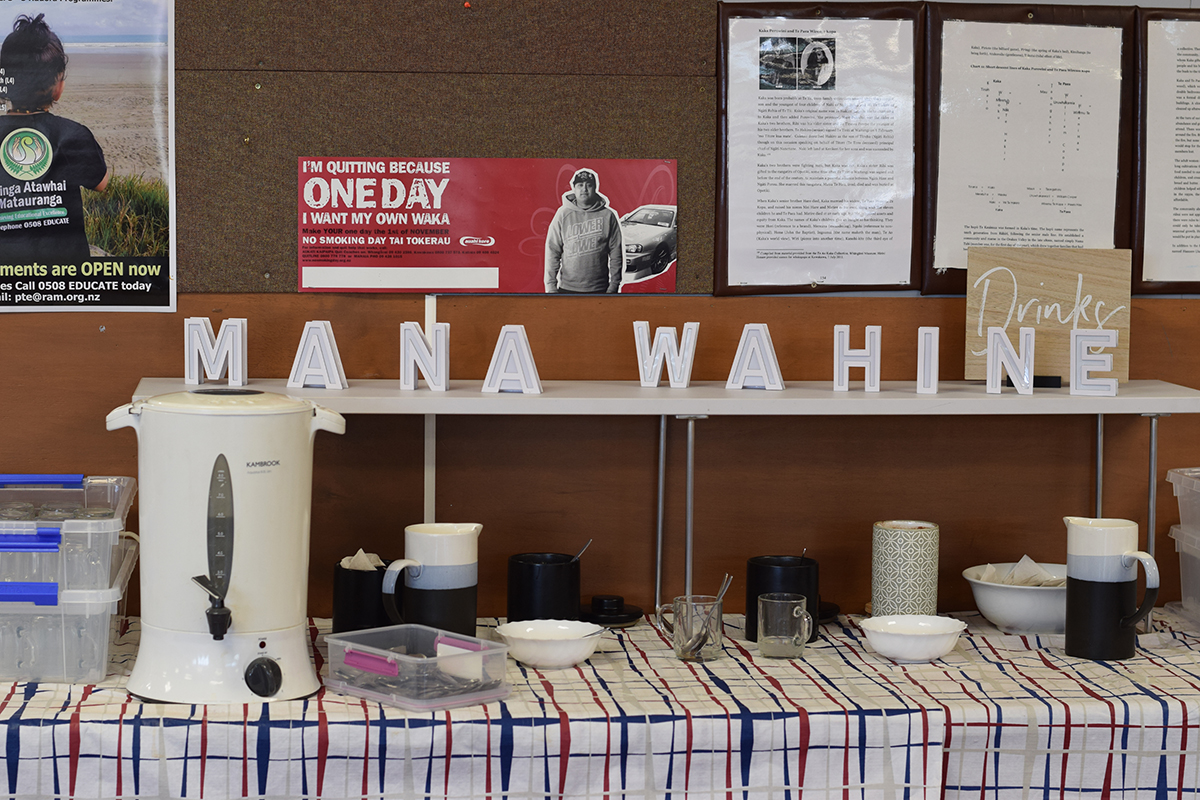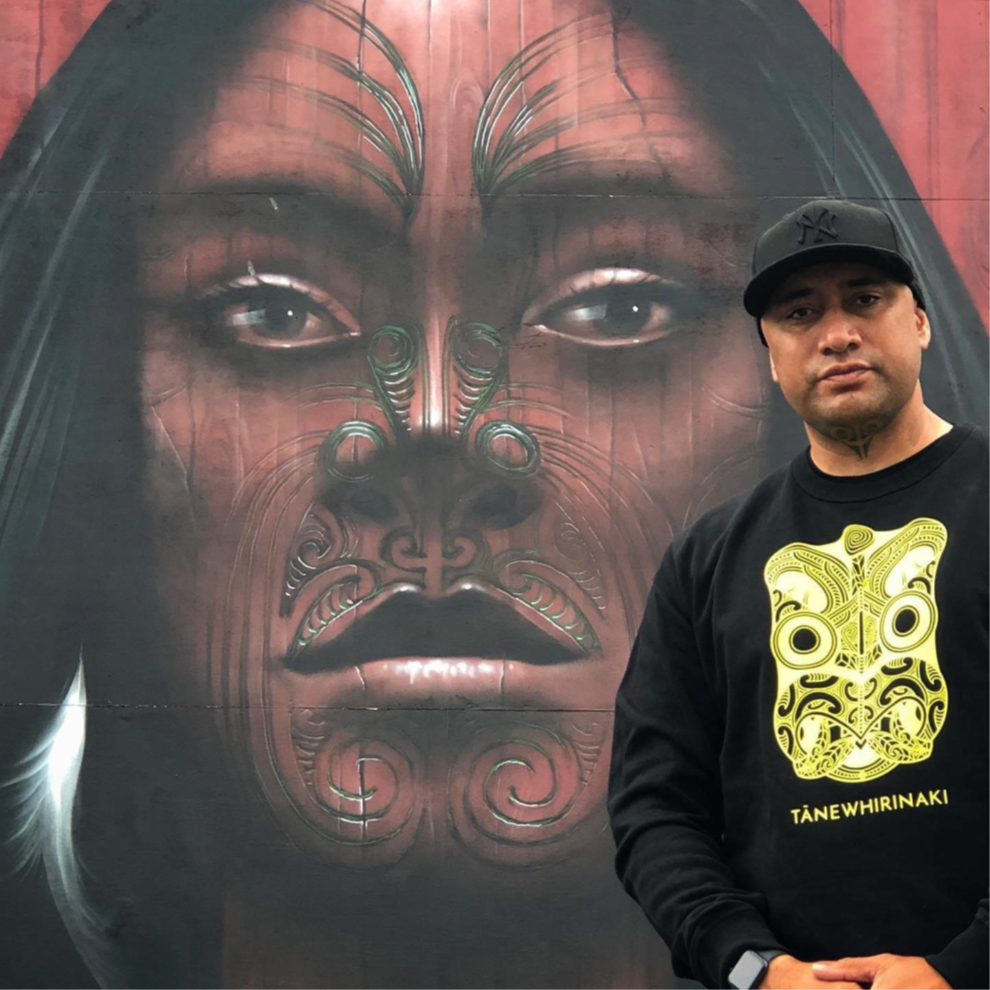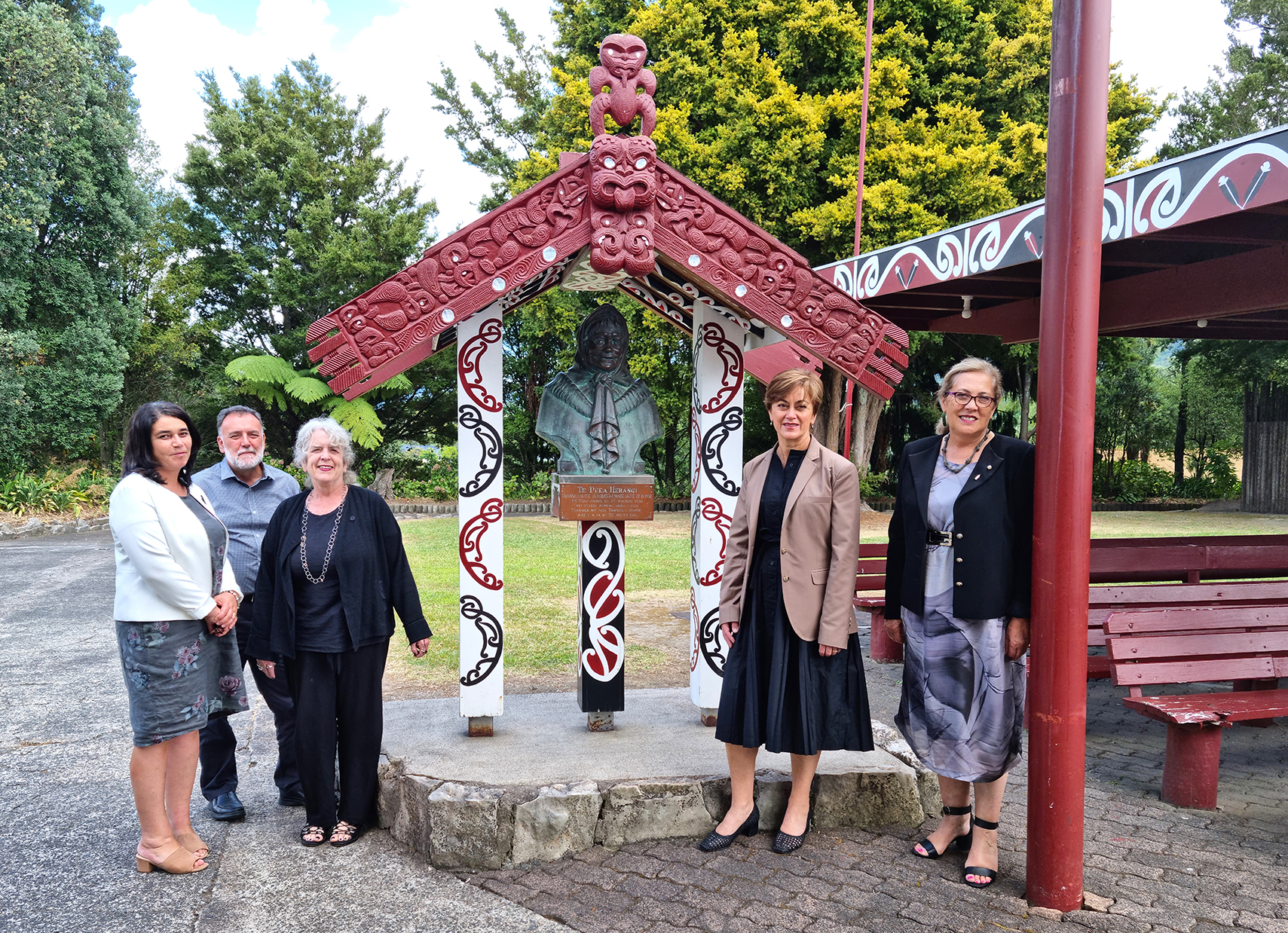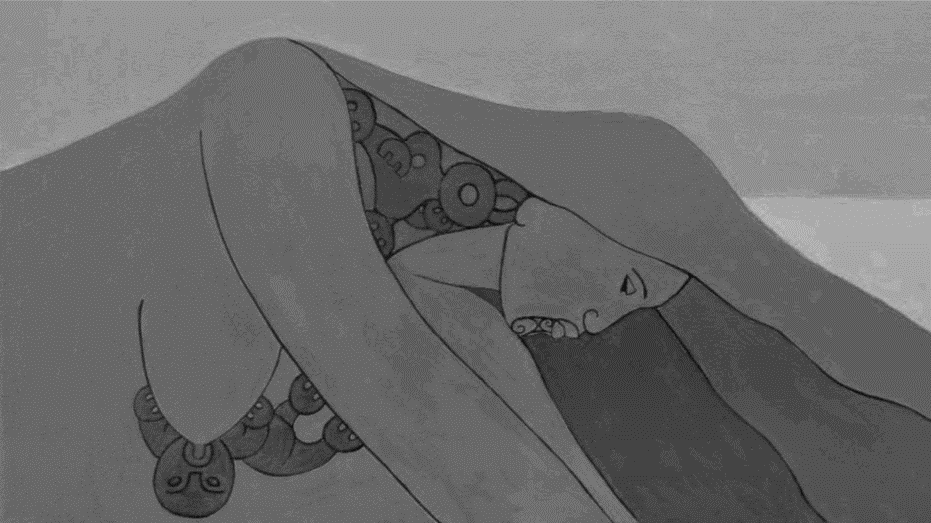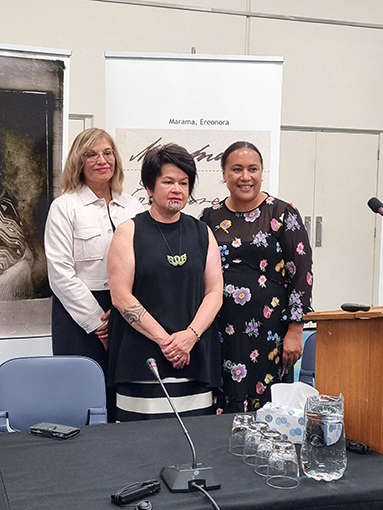The rangatira wāhine who signed te Tiriti o Waitangi
Ko ngā rangatira wāhine i haina ai te Tiriti o Waitangi
Several witnesses drew on the research of Miria Simpson, whose book Ngā Tohu o te Tiriti: Making a Mark(external link) identified 13 wāhine Māori as signatories to te Tiriti o Waitangi. One witness identified an additional female Tiriti signatory drawing on kōrero tuku iho (see: doc A136).
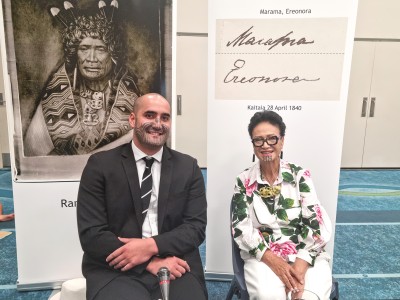
Tumanako Silveira (left) and Donna Awatere-Huata (right) pictured with Rangitopeora (left) and Ereonora's signature on te Tiriti (right)
Wāhine signatories of te Tiriti: Key quotes and briefs of evidence
Witnesses gave evidence about the following female signatories to te Tiriti o Waitangi. Within these descriptions, we have also provided additional information from Miria Simpson’s book and links biographical sketches of Tiriti signatures on NZHistory, the official website of Manatū Taonga Ministry for Culture and Heritage.
- Takurua – signed te Tiriti at Waitangi, 6 February 1840. Rīpeka Evans (doc A21)(external link) said that Takurua was the daughter of Te Kemera (Ngāti Takiwa) and the wife of Te Tai who also signed te Tiriti. Ms Evans cited Miria Simpson, who said Takurua had authority to sign on several counts: as the daughter of a rangatira and tohunga, the wife of a Rangatira, and as the mother of rangatira children’. For further biographical information, see: Takurua | NZHistory(external link).
- Te Marama – signed te Tiriti at Waitangi, 6 February 1840. Rīpeka Evans (doc A21)(external link) said that ‘[l]ittle is known about this signatory, including whether Te Marama was in fact a man or a woman. Miria Simpson concluded that ‘He wahine, he tane ranei Ehara, ka pea tenei i te ingoa tane. Te Marama is rarely a man’s name’. For further biographical information, see: Te Mārama | NZHistory(external link).
- Ana Hamu – signed te Tiriti at Waitangi, 6 February 1840. Rīpeka Evans (doc A21)(external link) noted that Ana Hamu’s late husband Te Koki signed the Declaration of Independence on October 28, 1838 (doc A21, p 9). He was a rangatira of Te Uri-o-Ngongo, and brother of Tuhikura (mother of Hongi Hika). Of Ana Hamu, Miria Simpson said ‘With her own land interests, Ana Hamu would have signed the treaty in her own right as a land owner’. For further biographical information, see: Ana Hamu | NZHistory(external link).
- Ereonora – signed te Tiriti at Kaitaia, 28 April 1840. According to Rīpeka Evans (doc A21),(external link) Ereonora was a very high-ranking woman married to the influential Te Pātu and Te Rarawa chief Nopera Pana-kareao (who also signed te Tiriti at the Kaitaia hui). Ripeka Evans quoted Angela Ballara’s entry on Ereonora in The Dictionary of New Zealand Biography, which said she agreed to the treaty ‘in her own right... A[nother] measure of her influence lies in the fact that Te Ruki Kawiti of Ngāti Hine tried to solicit the support of Pana-kareao to expel the governor by first speaking to Ereonora’ (doc A21, p 10). For further biographical information, see: Ereonora | NZHistory(external link) and Nōpera Pana-kareao | NZHistory(external link).
- Rangi Topeora – signed te Tiriti at Kapiti, 14 May 1840. Witnesses Elaine Bevan, Jane Wilson and Nganeko Wilson (doc A119)(external link) consider that she signed it for political reasons on behalf of Ngāti Toa and Ngāti Raukawa, and to secure her own mana (doc A119, p 4). These witnesses also note that Te Rangitopeora’s brother, Rangihaeata, refused to sign unless his sister did (doc A119, p 5). For further biographical information, see: Rangi Topeora | NZHistory(external link).
- Kahe Te Rau o te Rangi – signed te Tiriti at Port Nicholson, 29 April 1840. According to witness Ngaropi Cameron (doc A113),(external link) Kahe Te Rau o Te Rangi was sent by her iwi, Ngāti Toa Rangatira, to sign Te Tiriti. Because of her whakapapa and mana, she was sent in place of the recently deceased Te Matoha. Kahe Te Rau o Te Rangi’s kinswoman Rangi Topeora was another signatory, while her uncles Nohorua and Te Rauparaha; cousins Te Hiko, Te Rangihaeata, and Katu; and nephew Matene Te Whiwhi also signed Te Tiriti on different days. For further biographical information, see: Kahe Te Rau-o-te-rangi | NZHistory(external link).
- Te Rere o Maki – signed te Tiriti at Whanganui, 23 May 1840. Hinemoa Ranginui-Mansell (doc A129)(external link) said that Te Rere o Maki was the sister of Te Anaua and Te Māwae and the mother of Te Keepa Te Rangihiwinui or Major Kemp, but did not provide any further detail about the circumstances of her signing te Tiriti. For further biographical information, see: Rere-ō-maki | NZHistory(external link).
- Hoana Riutoto – signed te Tiriti at Waikato Heads, late March or early April 1840. From Ngāti Mahuta at Kāwhia, she was an ancestor of both Kīngitanga (Māori King movement) leader Te Puea Hērangi and land rights campaigner Eva Rickard. Paihere Clarke (doc A141)(external link) acknowledged Hoana Riutoto as a ‘notable rangatira wāhine who signed Te Tiriti for the Waikato Region’ (doc A141, p 4). For further biographical information, see: Hoana Riutoto | NZHistory(external link).
- Te Wairākau – signed te Tiriti at Waikato Heads, late March or early April 1840. Like Hoana Riutoto, Te Wairākau was a notable rangatira wāhine who signed Te Tiriti at the Waikato Heads mission station in late March or early April 1840. Paihere Clarke (doc A141)(external link) said that she too was an ancestor of Te Puea Hērangi, who led the Waikato opposition to conscription and established Tūrangawaewae, the seat of the Kīngitanga (doc A141, p 4). For further biographical information, see: Te Wairākau | NZHistory(external link).
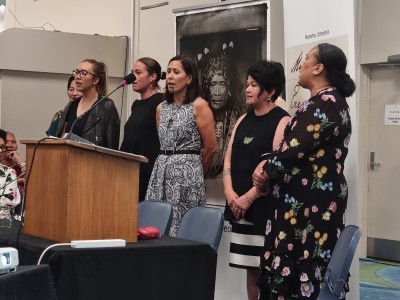
Rīpeka Evans with whānau, at Turner Centre, Kerikeri
The following Tiriti signatories have also been identified as wāhine by Miria Simpson, but witnesses in the tūāpapa phase of the Mana Wāhine inquiry did not give evidence about them:
- Marama – signed te Tiriti at Kaitaia, 28 April 1840. For further biographical information, see: Mārama | NZHistory(external link).
- Pari – signed te Tiriti at Rangitoto, 11 May 1840. For further biographical information, see: Pari | NZHistory(external link).
- Te Kehu – signed te Tiriti at Cook Strait, 19 May 1840, three days after her husband Rere-tāwhangawhanga signed the same treaty sheet at Waikanae on 16 May 1840. For further biographical information, see: Te Kehu (Te Whetū-o-te-ao) | NZHistory(external link) and Te Rere-tā-whangawhanga | NZHistory(external link).
- Ngaraurekau – signed te Tiriti at Waikanae, 16 May 1840. In Miria Simpson’s assessment, Ngaraurekau was more likely to be a woman’s name(external link). For further biographical information, see: Ngā-raurēkau | NZHistory(external link).
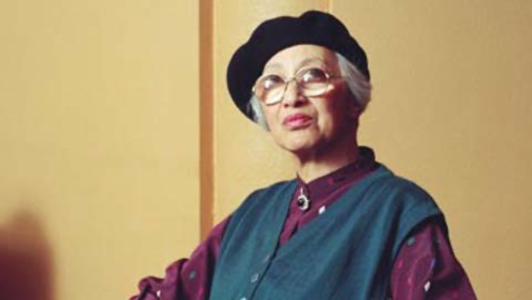
Miria Simpson (pictured in document A98(b))
